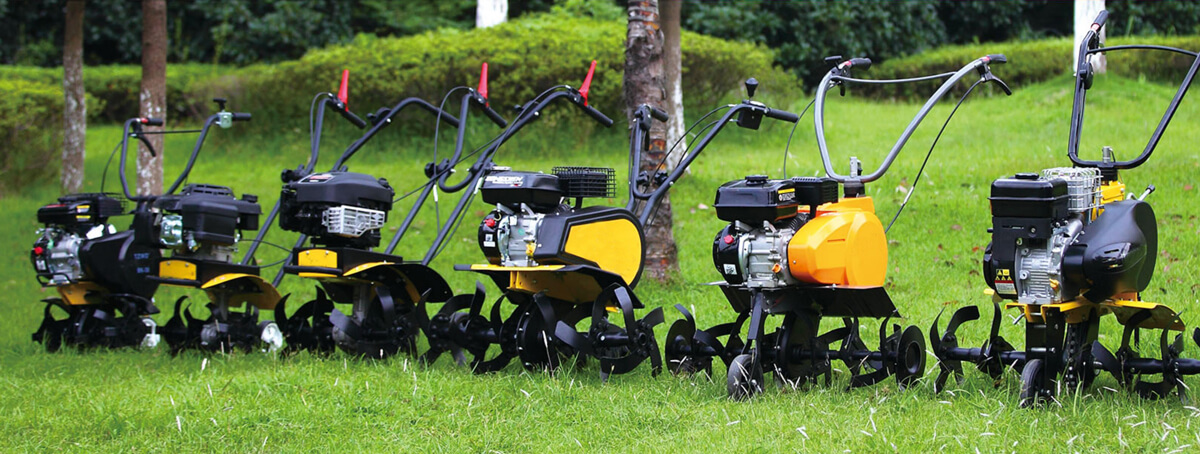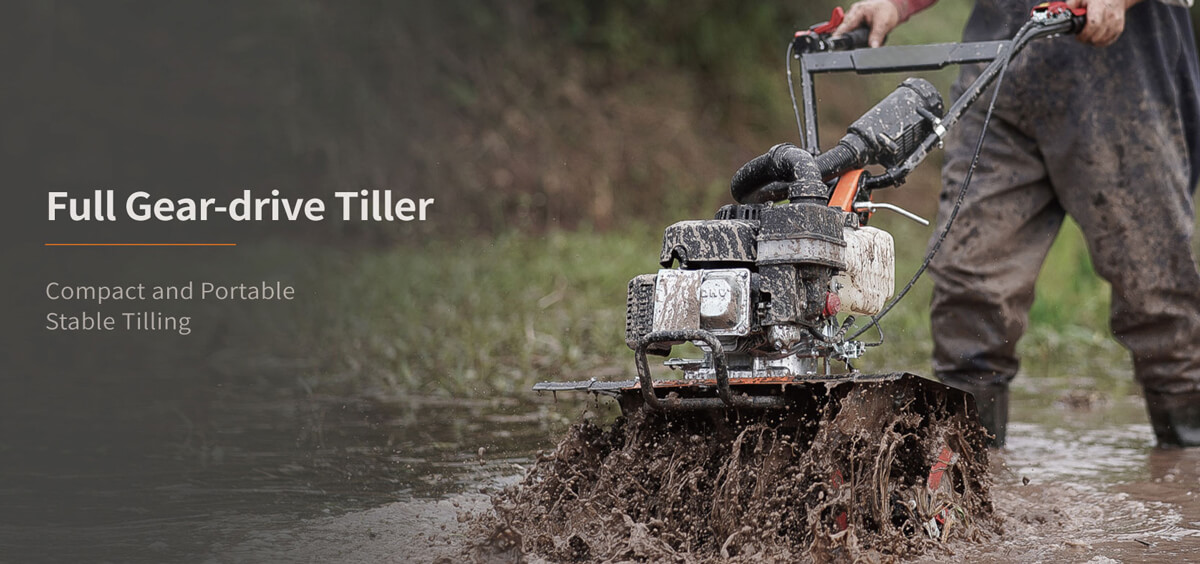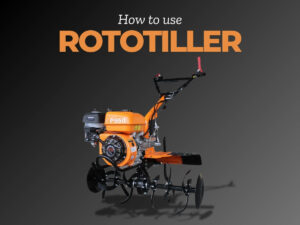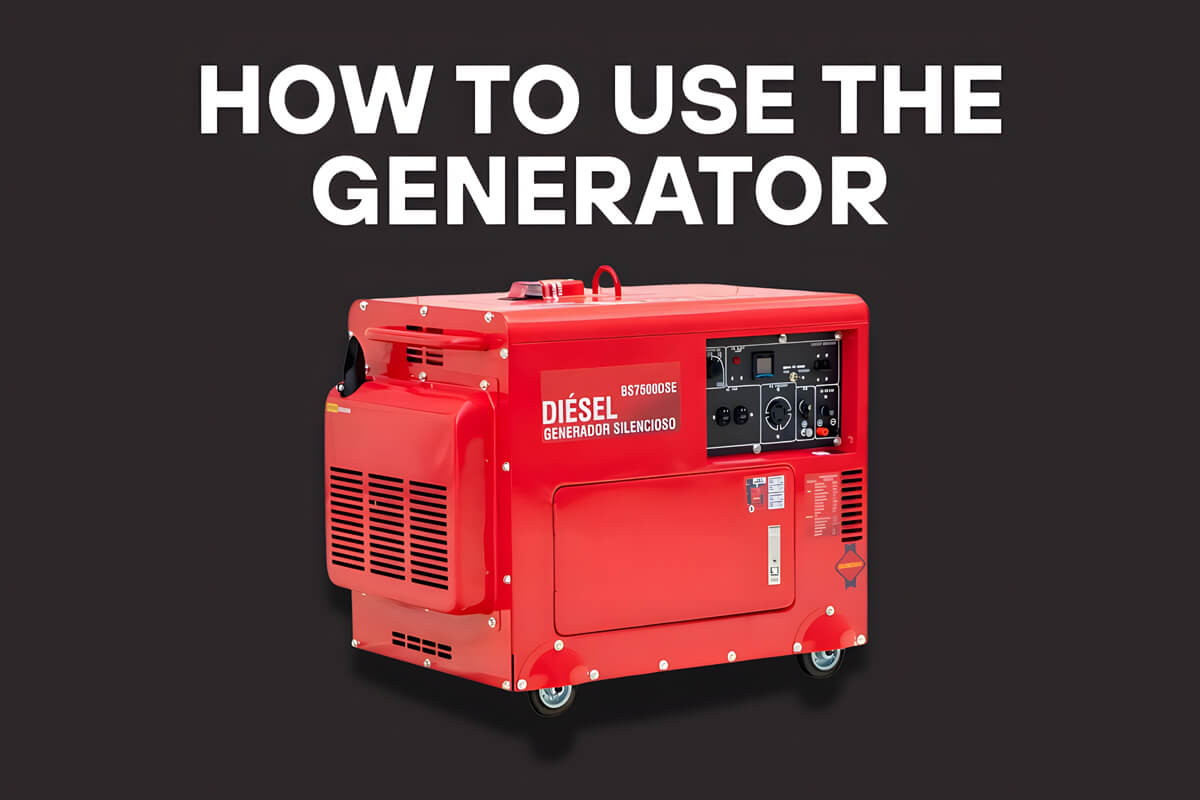what is a rototiller?
Proper soil preparation is the foundation of successful growing, whether for a small home garden or large-scale farming operation. Well-aerated soil allows roots to penetrate deeply, improves drainage, enhances nutrient availability, and creates the ideal habitat for beneficial soil organisms.
Whether you’re breaking up new ground for vegetable planting, aerating compacted soil, or mixing in compost and manure, a rototiller can save you time and effort while ensuring optimal soil conditions.
In this article, MATCHUP will explore everything you need to know about rototillers: what they are, how they function, their various types and sizes, and the significant benefits they offer to gardeners and farmers alike. By the end, you’ll understand why this powerful garden power tool has become indispensable for anyone serious about cultivating healthy soil and thriving plants.

Understanding rototillers
At its core, a rototiller uses a set of rotating blades, called tines, to break up, loosen, and aerate the soil, preparing it for planting. It transforms the traditionally demanding task of soil preparation into a more efficient and less physically taxing process. This tool is commonly used in gardening, farming, and landscaping to develop a suitable seedbed, incorporate organic matter, and improve soil structure.
While you may hear rototillers referred to by several names, such as rotary tiller, garden tiller, or soil cultivator, all these terms describe machines with the same fundamental purpose: to prepare soil efficiently for optimal growing conditions. There are some distinctions, though:
- Cultivators typically refer to smaller, less powerful models designed for light-duty work in established gardens.
- Tiller can be used for both rototillers and non-rotary tillers (like those with reciprocating blades).
- Garden tillers are generally machines sized for home garden use rather than agricultural purposes.
Regardless of the terminology, a rototiller is an essential tool for creating the perfect growing environment with minimal physical effort.
How rototillers work
The operating principle is straightforward. The machine features sharp metal blades (tines) connected to a rotating shaft. When powered—either by electricity, gasoline, or battery—these tines spin rapidly, digging into the soil and performing several important functions. This mechanical action accomplishes in minutes what would take hours with manual tools. The rotating tines create a churning motion that breaks apart soil clumps, incorporates organic matter, and creates a consistent texture ideal for planting.
Main components of a rototiller
A typical rototiller consists of several key parts:
- Engine/motor: The power source that drives the machine. Located at the top of most models, the engine provides the necessary force to turn the tines.
- Transmission: Connects the engine to the tines, transferring power and allowing for speed adjustments. Some models offer multiple speeds or the ability to reverse direction.
- Tines: These metal blades do the actual work of breaking up soil. They come in different shapes and configurations, optimized for various soil types and tilling depths.
- Handlebars: Provide control over the machine’s direction and often house the operational controls.
- Wheels/drag bar: Help with stability and maneuverability. Some models use the rotating tines themselves for forward movement.
- Shield/guard: Protects the operator from flying debris and ensures safety during operation.
Power source options
Rototillers are powered by different sources based on size and intended use:
- Gas-powered: Common for medium to large gardens. These models offer high power output and unrestricted mobility but require fuel, regular maintenance, and produce emissions. Typically range from 3-15 horsepower.
- Electric-powered: Connected to an electrical outlet via a cord, these units are quieter, lighter, and require less maintenance. Ideal for smaller gardens.
- Battery-powered: Cordless models that combine the mobility of gas tillers with the clean operation of electric ones. Battery life typically allows 30-45 minutes of continuous operation, suitable for most home gardens.
The tilling action
As the tines spin—typically at several hundred RPM—they dig into the soil in a repetitive pattern. Depending on the model, the tines can rotate in different directions:
- Forward-rotating tines (FRT): Rotate in the direction of the wheels, ideal for light soil and moderate gardening tasks.
- Counter-rotating tines (CRT): Rotate in the opposite direction of the wheels, providing additional power to break up hard or compacted soil.
- Dual rotating tines (DRT): Can switch between forward and counter-rotating modes, offering versatility for different soil conditions.

Types of rototillers
Different gardening needs call for different rototiller designs. Understanding the main types will help you select the right machine for your specific soil preparation tasks. The three main types of rototillers are front-tine, rear-tine, and mini-tillers. Choosing the right type depends on the area size, soil conditions, and depth required.
Front-tine rototillers
Front-tine tillers have rotating tines positioned in front of the wheels, offering several distinct characteristics:
- More maneuverable in tight spaces and between established rows
- Lighter weight (typically 20-60 pounds) and more compact
- Better for already-worked soil rather than breaking new ground
- Requires more operator effort as the tines’ rotation pulls the machine forward
- Generally more affordable, popular for home gardeners
- Tilling width typically ranges from 10-24 inches
These models excel in maintaining established gardens and working in confined areas where larger machines would be difficult to control.
Rear-tine rototillers
Rear-tine models position the tines behind the wheels, offering a different operating experience:
- More powerful and capable of breaking tough, virgin soil
- Heavier construction (often 100-300 pounds) provides stability
- Requires less physical strength to operate as the weight counterbalances the tine action
- Forward-rotating tines are standard, but counter-rotating tines are available for tough soil conditions
- Tilling width commonly ranges from 14-36 inches
- Often include adjustable depth settings
These robust machines are ideal for establishing new garden beds, breaking sod, or working in clay or rocky soil conditions. They are larger, heavier, and more expensive than front-tine tillers, making them suitable for serious gardeners and professional landscapers.
Mid-tine rototillers
Mid-tine tillers position the tines directly beneath the engine, offering a balance of power and maneuverability:
- Improved balance and easier handling
- Provides a good compromise between maneuverability and power
- Weight is more evenly distributed than front or rear-tine models
- Particularly effective for medium-sized gardens
Where are rototillers used?
A rototiller serves as a versatile garden workhorse that handles several essential soil preparation tasks. Rototillers are commonly used in a variety of horticultural and agricultural applications, including:
- Home gardens: Preparing small to medium-sized garden beds for flowers, vegetables, and other plants.
- Agricultural fields: Breaking up compacted soil for large-scale crop production.
- Soil amendment mixing: Adding manure, compost, and other organic matter to improve nutrient distribution.
- Weed control: Tilling uproots existing weeds and brings their seeds to the surface where they can be eliminated before planting. Light tilling between growing seasons can manage weeds without disturbing deeper soil layers.
- Improving soil structure: Regular tilling can improve heavy clay soil by incorporating organic matter and creating channels for air and water movement.
- Post-harvest cleanup: At season’s end, a rototiller incorporates plant debris into the soil where it can decompose, contributing to next year’s fertility.
A rototiller can make soil preparation faster and easier. It breaks up compacted soil, improves aeration, and mixes in nutrients to promote healthy plant growth. Regular tilling also helps control weeds, prepares beds for planting, and creates uniform conditions for better yields. Rototillers increase efficiency, extend the growing season, and make gardening more accessible—especially for larger areas or those with physical limitations.
How to use a rototiller
Proper use of a rototiller ensures effective soil preparation, prevents damage to the machine, and minimizes unnecessary strain on the user. Follow these steps to achieve the best results:
- Clear the area – Remove debris like rocks and sticks. Lightly water dry soil beforehand but avoid working in wet conditions.
- Set depth – Begin shallow, increasing with each pass. For garden beds, 4–6 inches are usually sufficient.
- Start the machine safely – Check oil and fuel (gas models), or ensure cords are safe (electric). Follow manufacturer instructions.
- Tilling technique – Work in straight lines, letting the machine move at its own pace. Avoid forcing it through compacted soil.
- Make multiple passes if needed – Especially in hard or new soil, repeat passes while deepening gradually.
- Section large areas – Tackle big plots in smaller segments for control and consistency.
- Don’t over-till – Once the soil is well-aerated and mixed, stop to protect structure and beneficial organisms.
- Post-use care – Clean the tines, check for damage, and store the machine in a dry place.
For more in-depth guidance on techniques and rototiller types, consider reading this detailed article: https://outdoormachinery.com/how-to-use-a-rototiller/
Regular maintenance schedule:
- Oil changes: Replace engine oil according to manufacturer recommendations (typically every 25-50 operating hours).
- Spark plug: Inspect, clean, and replace annually or as specified in the manual.
- Air filter: Clean every 5-10 hours of operation; replace as needed.
- Fuel filter: Replace annually on gas-powered models.
- Belt tension: Check and adjust drive belts to prevent slippage. Inspect belts and cables for proper tension and integrity.
- Lubrication: Apply grease to fittings and moving parts as directed.
- Tine sharpening: Sharpen or replace dull tines to maintain efficiency. Worn tines reduce performance.
Seasonal storage:
- Fuel: Drain fuel completely or add fuel stabilizer for gas engines.
- Oil: Change oil before extended storage to prevent acidic buildup.
- Cleaning: Clean thoroughly and apply light oil to tines to prevent rust.
- Storage: Store in a dry, covered location away from weather extremes. For electric models, store batteries according to manufacturer guidelines.
Troubleshooting common issues:
- Engine won’t start: Check fuel level, spark plug connection, and switch position.
- Weak performance: Inspect air filter for clogs, check for fuel quality issues.
- Excessive vibration: Look for damaged or unbalanced tines, loose hardware.
- Tines not turning: Inspect for jammed objects or broken belts.
- Transmission problems: Check oil levels and look for leaks.
Extending service life:
- Keep a maintenance log to track service intervals.
Use manufacturer-recommended replacement parts. - Avoid overworking the machine beyond its intended capacity.
- For infrequent users, run the engine briefly every 1-2 months during the off-season.
- Monitor belt condition and replace at the first signs of wear.
- Clean or replace air filters more frequently in dusty conditions.
- Change the oil regularly in gas-powered tillers and use fresh fuel to prevent engine problems.

Conclusion
A rototiller is an essential tool for soil preparation, making gardening and landscaping more efficient and less labor-intensive. Whether you’re a home gardener or a professional landscaper, selecting the right tiller and using it effectively can improve soil quality and boost plant growth. Understanding how a rototiller works, its benefits, and how to maintain it ensures long-lasting performance.
Modern models continue to evolve with technological advancements, offering more user-friendly features, fuel efficiency, and eco-friendly options. Adjustable tilling depths and variable speed controls cater to different soil types and gardening needs.
Whether starting a new garden, revitalizing soil, or maintaining existing beds, a quality rototiller provides the foundation for gardening success. Investing in MATCHUP rototiller allows you to expand your growing possibilities while protecting your body from the strain of manual digging.

May Ge
Outdoor Machinery Export Manager 6-Yr Exp 🌍 ∣ BSCI, EPA, EURO V, CE ∣ Generator, High-pressure Washer, Water Pump, Engine, Floor Scrubber ∣ 🚀 24/7 Second Reply
TAIZHOU BISON MACHINERY CO.,LTD | Ningbo University of Technology
Our related blog

how to use a rototiller
In this article, you’ll learn how to use a rotary tiller. Used safely and effectively, it can create an ideal soil bed for successful planting.








